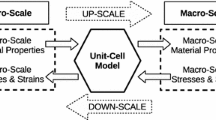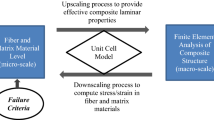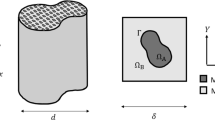Abstract
A method of estimating the fracture surface energy of fibre-reinforced materials is discussed. The surface work is shown to increase with increasing fibre content, strength and diameter, and decrease with increasing fibre modulus and matrix flow stress (or hardness).
Relatively short fibres should be used if high toughness is required, and the maximum toughness that can be achieved is limited by the amount of crack opening that can be permitted. Under certain conditions, incorporation of fibres into a material can lead to embrittlement.
Similar content being viewed by others
Abbreviations
- c :
-
half length of crack
- d :
-
fibre diameter
- D :
-
average separation of nearest neighbour fibres
- E :
-
Young's modulus
- G :
-
shear modulus of matrix
- K :
-
fracture toughness
- L :
-
length of fibre on either side of crack
- n :
-
number of fibres per unit area
- P :
-
force on fibre
- R :
-
pressure exerted by matrix on fibres
- u :
-
displacement
- U :
-
work
- x :
-
distance
- β :
-
8 G/d 2 E fr log(2π/p √ 3)
- γ :
-
surface energy or work
- ε:
-
tensile strain
- φ :
-
σfm E mr/Efr R
- σ:
-
tensile stress
- Τ:
-
shear stress
- μ:
-
coefficient of friction
- ν:
-
Poisson's ratio
- c:
-
composite
- e:
-
elastic
- f:
-
fibre
- m:
-
matrix
References
A. Kelly and G. J. Davies, Met. Rev. 10 (1965) 1.
M. R. Piggott, Acta Met. 14 (1966) 1429.
D. Cratchley, Met. Rev. 10 (1965) 79.
N. J. Wadsworth and I. Spilling, Brit. J. Appl. Phys. 1 (1968) 1049.
G. Cooper and A. Kelly, J. Mech. Phys. Solids 15 (1967) 279.
A. H. Cottrell, Proc. Roy Soc. A282 (1964) 2.
C. O. Hulse and B. A. Jacob, Am. Ceram. Bull. 47 (1968) 371.
S. D. Antolovich, Metal Sci. 3 (1969) 45.
D. Cratchley and A. A. Baker, Metallurgia 69 (1964) 153.
J. O. Outwater and M. C. Murphy, 24th Ann. Tech. Conf., Soc. Plastic Industry Section 11-C, p.1.
G. Cooper and A. Kelly, ASTM STP 452 (1969) 90.
D. L. Mcdaniels, A. W. Jech, and J. W. Weeton, Trans. Metall. Soc. AIME 233 (1965) 636.
L. J. Ebert, S. S. Hecker, and C. H. Hamilton, J. Comp. Mat. 2 (1968) 458.
Author information
Authors and Affiliations
Rights and permissions
About this article
Cite this article
Piggott, M.R. Theoretical estimation of fracture toughness of fibrous composites. J Mater Sci 5, 669–675 (1970). https://doi.org/10.1007/BF00549751
Received:
Accepted:
Issue Date:
DOI: https://doi.org/10.1007/BF00549751




